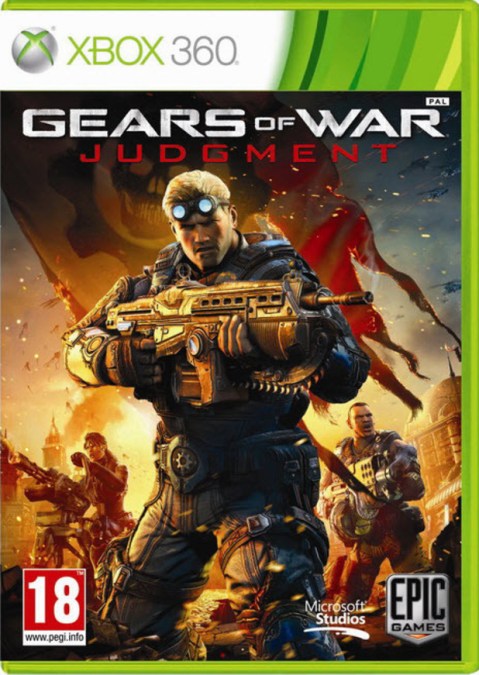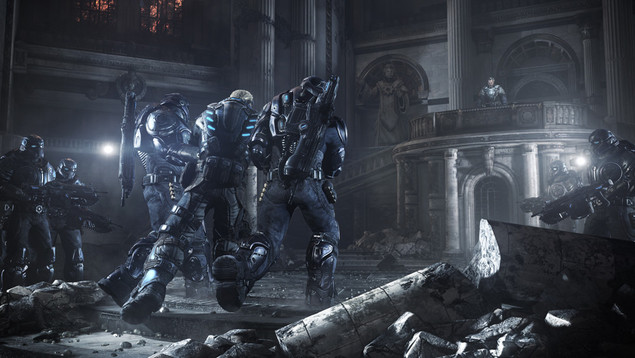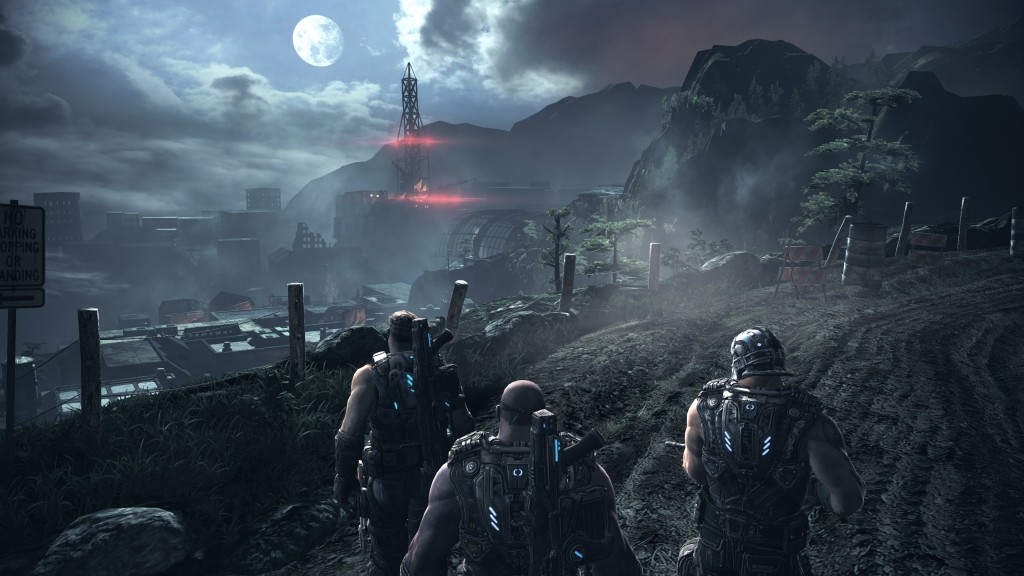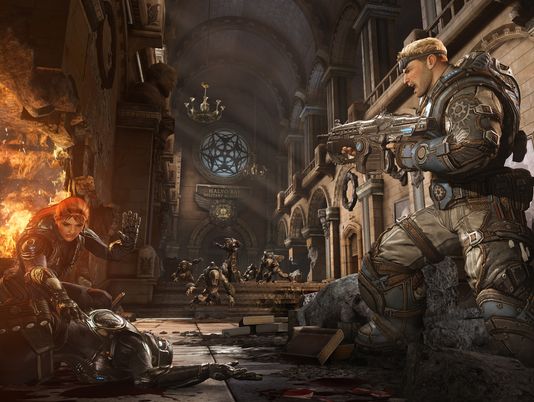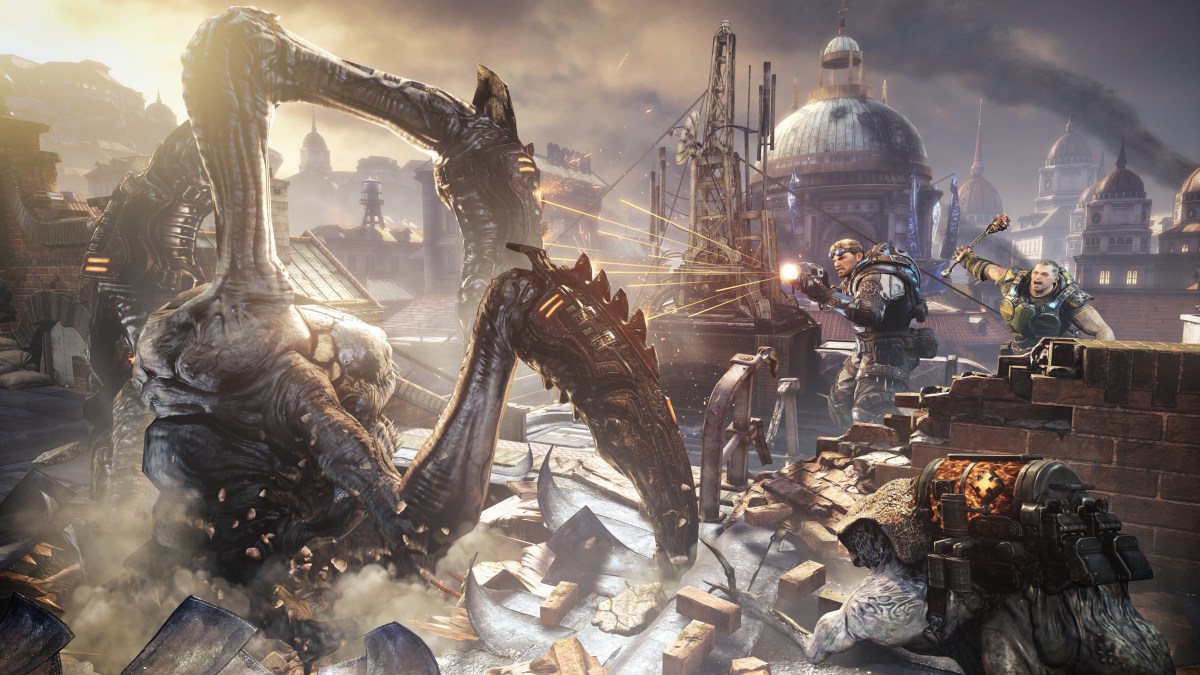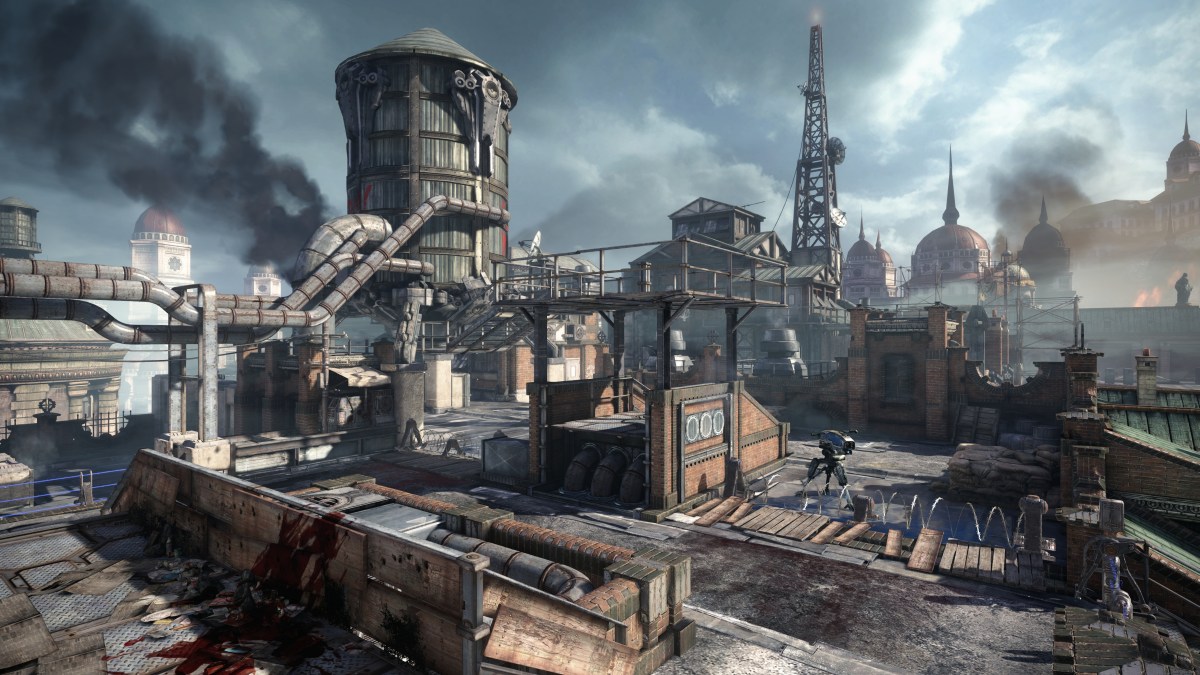Platforms: Xbox 360
Reviewed On: Xbox 360 (Duh)
Developer: People Can Fly, Epic Games
Publisher: Microsoft
Singleplayer: Yes
Co-op: Yes
Multiplayer: Yes
PEGI: 18+
Gears of War is back with its fourth entry in the series, but this time things are a little different with developers People Can Fly, who are best known for Bulletstorm, at the helm, with Epic Games taking on the role of backseat driver, yelling and cursing at anything they deem wrong. Considering Gears of War is one of Microsoft’s biggest franchises, right next to Halo, there’s been surprisingly little hype surrounding Gears of War: Judgment, especially in comparison to the vast advertising campaign that was behind Gears of War 3. So, the big question is does Judgment do the series proud?
This time around the focus is on snarky Baird and his best buddy Cole, back when they were members of Kilo squad just after Emergence Day – That’s the day when everything went up a certain creek without a certain valuable paddle, in case you had forgotten. The narrative set up is that Kilo Squad have been brought up on charges for disobeying direct orders to bring down big baddie Karn, and are in the middle of their trial. The story is told through the squads testimony as they explain their actions to Colonel Loomis, a man who you’ll quickly grow to despise. As the basis for a tale goes, it’s a pretty neat idea as it allows the writers to let the characters themselves provide narration and explain certain things. And yet it’s an idea that’s never used to its full potential, which is disappointing. In fact Judgment is the lightest storyline in a Gears game yet, so paper-thin that it’s in danger of ripping apart to reveal the barely covered innards . The problem isn’t that the overall storyline is simple – in fact I much prefer a well told simple tale over a complex jumble – it’s that it’s just not interesting, and the characters within it barely say anything.
The many trailers leading up to launch showed a Baird with all of his snarkiness and sarcasm intact, and yet surprisingly Judgment is a humorless game. Nobody could say that the previous games in the series were full of comedy gold, but Baird and Cole provided some smirk worthy moments during their adventures. Here, though, Baird’s snarkiness is very toned down, and both he and Cole feel strangely subdued. There’s barely any smartass quips from Baird or “woos” from Cole. The few attempts at humor fall flat on their face, and the squad banter is utterly lifeless. In fact the dialogue in general is pretty poor, with some truly cringe worthy lines, which is a shame because the quality of voice acting is superb.
There’s also two new characters along for the ride beside Baird and Cole. Sophia is a by-the-book Onyx guard cadet, while Paduk used to be a member of the UIR forces, who actually fought against the COG previously, that’s found himself fighting alongside his old foes against the Locust invasion. Again, though, there’s really just not much time for building up these characters, and so sadly the result is that Sophia is largely forgettable. Paduk, on the other hand, is a bit more interesting, and his former allegiances create a couple of cool moments. Again, it’s just a shame that more time wasn’t given over to exploring his character and all of the situations that could have arisen from it.
The only time the story picks up is in the Aftermath campaign, which is unlocked during play. This mini-campaign takes place during the events Gears of War 3 when Baird and Cole were sent off to get reinforcements. It’s plainly clear that this was originally supposed to be DLC for Gears of War 3, until it was presumably scrapped and later picked up for Judgment. Here the humor goes back to being in line with the previous gives, providing a few smirk worthy moments from Baird and Cole, while Paduk also gets to make an appearance.
The Gears of War games have never really been about story, but they’ve always had a sense of action-flick fun that makes them enjoyable. Sure, they’re full of meathead characters, but they’re a likable bunch of meatheads. In Judgment, though, the storyline simply falls flat. It doesn’t have the same epic (HA!) sense as the previous games, nor does it tell a more character driven plot. In fact, the ensemble of characters don’t really say very much at all. It really feels like both Baird and Cole could have been replaced with any character and it wouldn’t have made a difference, and that’s clearly not right.
Underneath the thin narrative veneer lies the classic, super-slick Gears of War gameplay we know and love, but with People Can Fly at the helm it’s got a whole new feel to it. The cover system is as fluid and satisfying as it has ever been, but now the Locus hordes are present in far larger numbers than we’ve ever seen outside of cutscenes, – with multiple Boomers, Therons and Maulers pretty common in each section – and they’re far more aggressive to boot, willing to get up close and personal. The result is a Gears of War game where I actually spent more time out of cover than I did in cover, which is a strange feeling when you’re playing a game from a series that has always been known for its cover based combat. But the large numbers of enemies and their willingness to bring the fight to you means you can’t stay in one place for long.This produces more intense action that we’ve ever seen from the series in the past. Whether the shift in gameplay style is good or not falls largely to personal opinion – I for one enjoyed it quite a lot. To balance this out there are a few moments where the game gives you space for longer-range conflicts, though a few more of these such sections would have been greatly appreciated. New weapons and enemy types are also present, helping to keep the combat feel fun and fresh.
Some small changes to the controls have also been implemented. Weapons are now swapped between by tapping Y, and grenades are used by holding down the LB button, or tapping it to quickly toss them.
Another new interesting dynamic comes in the form of a smart spawn system, which changes up the enemies you’ll face any time you die and respawn, or replay a section. For example you might play through the section and face Cleaver wielding Therons and charging Maulers, and then face Boomers, Grenadiers and Wretches the next time. It’s a great idea and obviously gives the game some solid replay value as you’ll always face a new challenge.
Another thing that gives the game better replay value than past titles is its unusual campaign structure which sees every mission split into 6 bite-sized combat scenarios that last an average of about 5-10 minutes each, with very few moments went you aren’t in a pitched battle. At the end of each chunk you’ll be greeted with an arcade style score sheet which tallies up your performance and awards you stars accordingly. It’s worth noting here that you actually earn XP in the singleplayer that carries over to the multiplayer, so by finishing the campaign alone you’ll have gained a few online ranks. Stars also unlock some items as well. Anyway, this unusual campaign structure obviously makes it great for replaying, and it gives it an almost Arcade feel – it just needs to ask you to insert a coin to continue and the illusion will be complete. On the other side of the imaginary fence, this structure also means the campaign doesn’t really flow very well, since you’re stopping every few minutes to stare at the scoresheet. It can be a little jarring to not have the seamless campaign from the past three games.
Having Kilo squad on trial also provides the narrative set up for another interesting new idea that People Can Fly have introduced: Declassfied testimonies. These take the form of glowing red skull COG symbols very clearly displayed at the start of each segment, which when activated essentially act like difficulty modifiers, bringing new variables into the action. For example, some particular highlights are having to fight through a Library that’s so dusty you can’t see more than a few feet in front of you – which was coupled with loads of Cleaver wielding Therons for me, making for an insane fight – or having to battle the Locust hordes with nothing but a pistol. They’re completely optional, but the upside of activating them is that your stars fill up faster, and they add a butt-load of variety to the combat, making for even more interesting fights. From a storyline point of view they’re explained as being classified parts of Kilo Squads testimony, or sometimes just as things that were omitted entirely from the official reports. To be honest, though, most of the time it doesn’t make all that much narrative sense – exactly why was the Library being dusty classified? And why the hell are we fighting with pistols, when we had Lancers and full ammunition when we came through the door? Regardless, Declassified missions are one of the best additions Judgment brings to the table, adding in loads of variety to the gameplay to ensure every fight feels different, and when combined with the difficulty settings ensure that even seasoned veterans of the series will face a hefty challenge.
As for the Aftermath campaign, it’s a little strange since it ditches most of the innovations made in the main Judgment campaign in favour of the more tradition Gears of War flavor. The bite-sized combat scenarios, scoresheets and Declassified missions are tossed out the window completely, reinforcing the idea that this was originally intended to be DLC for Gears of War 3, though happily all the new weapons and enemy types are still present.
Speaking of which, Gears of War: Judgment tackles the narrative issue of Baird and Cole encountering enemies that weren’t introduced until Gears of War 3, as well as why the new enemies and weapons don’t make appearances later in the timeline, by simply never mentioning it. There may be some fans left unhappy that this is never explained within the story, but to be honest it’s probably the best way to handle it. There was no sense in letting the cool enemy types introduced in Gears 2 and 3 go to waste, nor was there any sense in not introducing new stuff into Judgment. Sure, it would have been nice if People Can Fly could have woven it into the narrative fabric, but since they obviously felt they couldn’t it’s for the best to simply never mention it and trust gamers to accept that, well, it’s a game, so why the hell not?
Of course being a Gears of War game you can play through the entirety of both the Judgment and Aftermath campaign with up to three of your mates, or some random folk from that magical online world. And like the Gears of War games before it, co-op instantly makes everything several times more fun.
On the multiplayer front the big story is the new Overrun mode, the unholy offspring of Gears of War 3’s Beast mode. In this mode two teams face off against each other. One side plays as the COG forces trying to protect one of three E-Hole covers, while the other team play as the Locus horde hellbent on destroying the aforementioned covers. When a cover is destroyed play moves to the next cover, or if the Locust can’t destroy it before the time limit is up then the game is over, with teams swapping sides so that everyone gets to be play as both the Locust and COG armies. On the COG side of things you get emplacements to help you hold your ground, and a choice of four character classes to play as: the engineer can repair things and deploy sentry guns: the medic can revive her team with stim-grenades; the scout can clamber up to high ground and lob sensor grenades; and the soldier can drop ammo boxes and beat the snot out of the enemy team with a grenade launcher. Meanwhile on the Locust side you’ve got the choice of four Locust types as default, but by killing enemies and supporting your team you can earn points, which can in turn be cashed in to let you play as larger, more powerful Locust variations, like a Mauler or Corpser.
Overrun is an absolutely stellar addition to the multiplayer suite, and is arguably the single best thing People Can Fly did in Gears of War: Judgment. Playing as the COG, desperately trying to hold off the Locust forces is fantastic, and playing as the Locust trying to break through the defenses is equally fun. Teamwork is essential, and you’ll often find the players at the top of the leaderboards are the ones with high support scores, rather than high combat scores. My only real gripe is that on the COG side the Soldier class is far too powerful. His grenade launcher comes packing 6-rounds, but his Ammo box ability recharges so fast than he can keep himself stocked up without a problem, allowing the player to simply spam grenades, especially since they can be bounced around corners. It’s not uncommon to find teams with 2 or 3 soldiers working in tandem to spam grenades and keep ammo replenishing. To top it off the soldier also has a Lancer as a backup weapon, while other classes are more limited in their loadout.
The standard Team Deathmatch mode is also present and accounted for, along with a new Free-for-All mode, which does exactly what it says on the imaginary tin. The new maps in Judgment are fantastic and the modes offer up the same degree of insane Gears action that fans know and love. To help combat the feeling that shotguns were too dominating online, People Can Fly changed how loadouts work, so now you can only choose one gun when you go into battle – if you want that shotgun, that’s fine, but you won’t be able to take a longer range weapon as backup anymore. It’s a change for the better, though I’d still hazard that the fairly tight maps still often favor shotguns above all else, and the Lancers need a touch more damage output yet.
However, some other changes aren’t so welcome. The signature down-but-not-out of the previous games, wherein a player who took enough damage would drop to the floor and could crawl around until a teammate revived them or an enemy finished the job, has been removed completely in the standard versus modes (it’s still present in the campaign, and the Overrun and Survival modes). This also means that another of the series signatures, the brutal execution moves, have been removed. Presumably People Can Fly removed these two features to increase the overall pace of the action, but frankly it’s not a change for the better. Worse still, the removal of these features also means the loss of game modes such as Execution. Other game modes are also missing: there’s no King of the Hill, Wingman, Capture the Leader and Annex, to name but a few, leaving the total multiplayer modes available in Judgment at 4. However, some good news is that People Can Fly have announced that an Execution mode will be coming via download fairly soon for free. It’s a nice gesture from them toward us fans, but it doesn’t stop me wondering why they removed it from the game at all.
As for Horde mode, it has been removed in favor of Survival Mode, though the new Survival mode is so similar to Horde in its basic concept that at first you’ll wonder why they didn’t just continue the trend from past games and name it Horde 3.0. However, once you actually play it you’ll understand why. While it is similar in that you and up to three other people face off against waves of enemies, Survival Mode is nowhere near the same level of quality as Gears of War 3’s Horde mode. Survival mode plays out sort of like OverRun – Working together the COG players (the class system from OverRun is present here) need to defend E-Hole covers against just ten waves of enemies, rather than the 50 that we’ve become accustomed to from past iterations of Horde. The ability to purchase various defensive items has been removed entirely in favor of preset barriers that spawn at the beginning of the game that can be repaired by an engineer, but once they’re gone they’re gone. In other words, then, Survival mode is a pale shadow of the fantastic Horde mode, and probably won’t keep people playing for very long.
There’s also not a lot of maps packed on to Judgment’s disc. OverRun comes with four maps specific to it, while the versus modes also get just four maps. Happily the new map designs are fantastic, with more verticality present in some of them than we’ve ever seen from the series before, which is emphasised by the fact that players can now drop off of ledges, ensuring you’ll always be on your guard in case a falling COG lands on your head. Alright, I admit that was a crap joke, but come on! How couldn’t I do it? Anyway, the small amount of maps on offer, along with the stripped back amount of game modes, does mean the multiplayer components feel a little thin compared to previous series entries. There’s a decent whack of unlockable character and weapon skins, though. It’s a shame that going to view them is marred by the myriad of skins below available to purchase using Microsoft Points only.
Other changes in the multiplayer formula are small, but nonetheless important. Grenades can no longer be used deadly traps by sticking them to walls and there’s no more damage boosts from nailing an active reload, which is a real shame.
Gears of War: Judgment is something of a mixed bag, then. It offers up the best singleplayer combat experience that the series has seen, with an unusual but effect campaign structure. Yet while the series has never be known for narrative brilliance, it tells the weakest story to date, with the characters of Baird and Cole feeling oddly subdued and not used to their full potential. You’ll blast through the singleplayer offering in around 6-8 hours, but it’ll be a bloody fun 6-8 hours. OverRun is a fantastic addition to the Gears of War name, but has seemingly come at the expense of several other modes. With Horde mode replaced by the vastly inferior Survival, and other modes missing along with a fairly small map selection, Judgment feels like it has taken a large step backwards in terms of content.
Still, People Can Fly have shown that they can handle the Gears of War license well enough, if not quite to the same standard as Epic themselves. If Microsoft play it smart they’ll give People Can Fly plenty of development time for the next game, and then we’ll see what they can really do. Whether or not you should buy Judgment is simple: if you’re itching for more Gears of War, then you’ve probably already got it sitting on your shelf. And if you were feeling a bit tired of the formula by the end of Gears of War 3, then there’s not going to be enough here to drag you back in.
The Good:
+ Declassified testimonies add a lot of combat variety.
+ Combat is intense.
+ OverRun is awesome.
The Bad:
– Survival is a poor replacement for Horde.
– Weak storyline.
– Classic modes removed.
The Verdict: 3.5/5 – Good, bordering on great.
A must for Gears of War fans, the changes that People Can Fly are largely for the better, yet they’ve made some mistakes along the way. OverRun will likely be the centre of attention here, with the singleplayer campaign offering up the most intense combat in the series.

